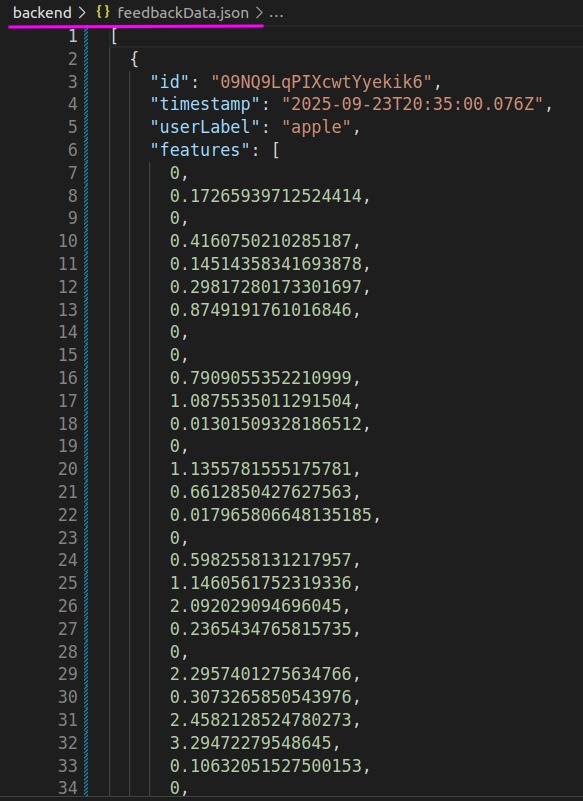On this update I did implement an Export Data script , this data object will contain all feedbacks (images labelled) by users, it will help me to train the model.
exportData.js
import { initializeApp } from "firebase/app";
import { getFirestore, collection, getDocs } from "firebase/firestore";
import fs from 'fs';
import path from 'path';
// Firebase configuration (hardcoded for this standalone script)
const firebaseConfig = {
apiKey: "########################",
authDomain: "########################",
projectId: "########################",
storageBucket: "########################",
messagingSenderId: "########################",
appId: "########################",
measurementId: "########################"
};
// Initialize Firebase
const app = initializeApp(firebaseConfig);
const db = getFirestore(app);
const exportData = async () => {
try {
const feedbackCollection = collection(db, "feedback");
const snapshot = await getDocs(feedbackCollection);
// Log the snapshot size to check if documents are retrieved
console.log("Number of documents retrieved:", snapshot.size);
// Map document to an array
const data = snapshot.docs.map(doc => ({ id: doc.id, ...doc.data() }));
// Ensure the output directory exists
const outputDir = path.resolve('./backend');
if (!fs.existsSync(outputDir)){
fs.mkdirSync(outputDir, { recursive: true });
}
// Save data to a file
const outputPath = path.join(outputDir, 'feedbackData.json');
fs.writeFileSync(outputPath, JSON.stringify(data, null, 2));
console.log(`Data exported to ${outputPath}`);
} catch (error) {
console.error("Error exporting data: ", error);
}
};
exportData();
it is executed by node on command line and the JSON file is saved on /backend folder where the model will train with the data.
node exportData.js

How the Model Works
- Input Features:
- The model takes a feature vector (e.g., new_features) as input. This feature vector represents some data (e.g., an image, user feedback, or other structured data) that was preprocessed and transformed into numerical values.
- Prediction:
- The model uses the patterns it learned during training to predict the class (e.g.,
0,1, etc.) that the input feature vector most likely belongs to.
- The model uses the patterns it learned during training to predict the class (e.g.,
- Decoding the Class:
- The numerical class (e.g.,
0) is decoded back into its original label (e.g.,"apple"or"pear") using theLabelEncoder.
- The numerical class (e.g.,
- Output:
- The model outputs the predicted label (e.g.,
"apple") for the given feature vector.
- The model outputs the predicted label (e.g.,
What This Means
- The model can take a feature vector (without a label) and predict which label (e.g.,
"apple"or"pear") it most likely belongs to. - This is because the model was trained on labeled data, where it learned the relationship between feature vectors and their corresponding labels.
Example Workflow
- Training:
- During training, the model was given feature vectors (e.g., extracted from images) and their corresponding labels (e.g.,
"apple","pear"). - It learned to associate specific patterns in the feature vectors with their labels.
- During training, the model was given feature vectors (e.g., extracted from images) and their corresponding labels (e.g.,
- Prediction:
- Now, when you provide a new feature vector (e.g., new_features), the model uses what it learned during training to predict the label for this feature vector.
Real-World Example
Imagine you have a dataset of fruit images:
- During training:
- The feature vector for an image of an apple is labeled as
"apple". - The feature vector for an image of a pear is labeled as
"pear".
- The feature vector for an image of an apple is labeled as
- During prediction:
- You provide a new feature vector (e.g., extracted from an image of an apple) to the model.
- The model predicts that this feature vector belongs to the label
"apple".
Key Points
- The model does not need the label during prediction. It only needs the feature vector.
- The label (
"apple","pear", etc.) is predicted based on the patterns the model learned during training.
I’ll appreciate your advices or feedbacks.
Comments are closed